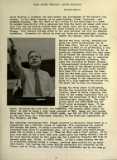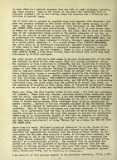Leigh Harline is probably the most modest and gentlemanly of Hollywood's composers. In his early forties, he is pood-looking, blond, blue-eyed , and slightly paunchy. Not the least of his virtues is his excellence as a hot. He extends hospitality with a gracious bow from the waist and makes each guest feel like the one person without whom the party could not be a success. On Christmas Harline usually invites his close friends in to share a bowl of Jul Gloegg. This festive holiday drink is his sole cultural tie with his Swedish ancenters. Otherwise his tastes in food and drink are international, leaning toward the unusual, even the exotic.
Harline was born, raised, educated, and given his first professional job in Salt Lake City. But he is now, by temperament as well as by profession, a confirmed Southern Californian. He has no nostalgic sentiments about his home town. Yet he helped the observance of the Utah centennary a few years ago by composing for the Utah Symphony Orchestra, then under the direction of Werner Janssen, a three-movement orchestral suite based on the story of the Mormon migrations. The performance of this suite enabled Salt Lake City to celebrate the hometown boy who made good. But after several days of celebration, Harline was glad to return to the comparative anonymity of a film composer who writes for, but never has to face his audience.
During his early years in Hollywood, Harline was associated with the Disney studios, where he wrote literally hundreds of the bouncy bagatelles that accompany the adventures of Walt Disney's anthropoglogic characters. The background music for SNOW WHITE was his first major assignment here. It was followed by the writing of all the music, including the song hits, for PINOCCHIO, the Academy Award winner for 1940. In 1943 he began a long-term contract at RKO. Among his best scores there were those for CHINA SKY, JOHNNY ANGEL, and THE BOY WITH THE GREEN HAIR. In the past year, as a free-lance composer, he has fulfilled commitments at Fox, Warners, and MGM.
The rewarding association with Disney resulted in Harline's being typed as a song-writer and a skillful scorer of comedies. This reputation has pursued him through the years, it being a practice in the industry to categorize everybody from stars to maintenance men. It is of course true that Harline knows how to write a good tune, as "When You Wish upon a Star" proves. It is also true that he has a deft hand with light music and comedy effects. One of his most amusing essays in this genre was for a modestly budgeted RKO film of several years ago, called A LIKELY STORY. It had a scene showing two men in silhouette arguing behind a screen; gestures were visible but no words were heard. For scoring the scene Harline marshalled his orchestra in two forces, one of brass, the other of strings and woodwinds; and he let them go at each other in a musical argument that was full of comic violence, hysteria, and bawdy insults. Some of the effect of the music was inevitably lost in audience laughter, but on the scoring stage the sequence was a hilarious exhibition of musical humor.
Yet it would not be correct to conclude from such examples that Harline's talents are properly defined by the 32-bar chorus and the comedy allegro in 2-4 time. His sense of real drama is equally well developed, as the CHINA SKY and JOHNNY ANGEL scores have demonstrated. Indeed, it is in such scores that he makes his best contribution to music for the films. Here he shows his awareness of the contemporary idiom coined by the master composers of our day, as well as his ability to deal with large musical thought. He shows also a decided preference for contrapuntal textures. For THE BOY WITH THE GREEN HAIR, for instance, he wrote a chase sequence in which a two-part canon was accompanied by a double pedal, inverted. In a recent Warner film, PERFECT STRANGERS, the title music is in three-part counterpoint. (Another interesting feature of this score is that it employs a classical orchestra of strings, double woodwinds, two horns, and one trumpet.) There is also a fugato main-title in THEY LIVE BY NIGHT, a film whose virtues were overlooked here until they were discovered by British audiences.
One other aspect of Harline's work seems to me more characteristic of him than the features by which he has been typed. This is a strong folk-music strain. His knowledge of folk literature is extensive, and his collection of material constitutes a major portion of his library. It was put to good use during the summer of 1946 when he directed "Gallery of American Music" for NBC. For this show he composed several short overtures based on popular folk tunes. One of these subsequently became a successful concert piece for the Southern California All-High School Orchestra. Several film scores have also served as outlets for this absorbing interest. THE FARMER'S DAUGHTER and THE VELVET TOUCH both had folk-like themes in the Scandinavian vein, and MAN ALIVE had a quick-moving river-boat song. But quite aside from the quotation of actual folk tunes, or the invention of melodies in folk style, there is frequently in Harline's music an unconscious use of modal and rhythmic materials that stem from folk sources.
There are, then, two very healthy trends in his music - the folk and contrapuntal elements. These have not, however, overcome certain other tendencies which make his music, considered as a whole, a not yet thoroughly integrated and personalized expression. One of these tendencies is the use of the lush harmonic idiom of French impressionism, which sometimes crops up as an anachronism in modern contexts. Another is the too frequent reliance on the sentimental theme song, a cliche imposed by industrial habit and the tastes of semi-cultivated producers. Most of Harline's colleagues are similarly subjected to this tyranny. It is unfortunate that the type of pictures to which Harline is so frequently assigned is precisely the type that appears to require the sentimental theme song as an indispensable adjunct to the film for purposes of publicity and exploitation. A flagrant example was somebody's idea (it certainly could not have been a musician's) of using "Nature Boy" as a theme for THE BOY WITH THE GREEN HAIR.
Apart from his music, Harline's principal interests lie in the fields of art and gardening. Both of these activities are Centered in the Harline home, a beautiful but unpretentious residence near the ocean at Palos Verdes. In recent years the Harlines have acquired a number of distinguished canvases, and Mrs. Harline is one of the moving spirits behind the exhibits organized for the Palos Verdes community. Harline's gardening appears to be as much a "linguistic" as a horticultural activity. One suspects that he cultivates his garden not only for the pleasure of watching things grow but also for the pleasure of telling visitors that what they call wild lilac, flowering trees, fuchsia, and native plants are really ceanothus impressus, Lagenaria pattersonii, escallonia rubra, and 22 varieties of bromeliads.

